Country
Crash of a Learjet 35A in Nuremberg: 3 killed
Date & Time:
Feb 8, 2001 at 1540 LT
Registration:
I-MOCO
Survivors:
No
Schedule:
Nuremberg - Rome
MSN:
35-445
YOM:
1981
Crew on board:
2
Crew fatalities:
Pax on board:
1
Pax fatalities:
Other fatalities:
Total fatalities:
3
Captain / Total hours on type:
54.00
Copilot / Total hours on type:
192
Circumstances:
During an inspection of the right engine a technician found chips in the oil filter. The damage should have been repaired within the next 20 flight hours. Since the maintenance organization in Switzerland, who usually carry out necessary repairs, did not have the spare parts available on time, the task was assigned to an organization in Nuernberg. On 07.02.2001, the airplane was ferried to Nuernberg and repaired in the presence of the chief technician of the operator. The repairs and the replacement of the parts exclusively on the right engine were certified properly. The return flight to Rome was planned for the 8th of February 2001 at about 1530 o’clock. A charter flight from Rome was to be carried out on the following day. Two pilots and the chief technician of the operator were aboard the aircraft. The flight preparation was carried out by phone from the repair facility. A weather briefing and the NOTAM´s for the flight were obtained properly. The check lists for the take-off were read. During the preparation the unbalanced fuel distribution between the right and left-hand tanks, and the fact that the total amount yet was equal on both sides was discussed. Immediately afterwards the second pilot noticed the failure of his gyro instruments. The airplane was taxied via the taxiways "Juliet" and "Foxtrot" to runway 10. Pilot at the controls was the pilot in command while the second pilot carried out the radio communications with the air traffic control. The pilots received the clearance for a departure via the departure route Noerdlingen (NDG 1 M) to Rome. The take-off was at 1531 o'clock. After 5 nautical miles the airplane turned to the south, following the departure route. At 15:33:49 o'clock the left-hand engine failed without a previous warning. The noise of a down running engine was also heard by several witnesses on the ground. Smoke or a fire was not seen by them. The second pilot reported an emergency with the left-hand engine shortly after the occurrence to the control tower and informed them that they wanted to return for a landing on the runway 10. At that time there were visual meteorological conditions, and the runway was continuously to be seen. Since the departure control Nuernber APP wished to coordinate the flight, the frequency was changed for a short time upon request. After the second pilot had declared the emergency once again they switched back to the tower again and continued the approach to runway 10. Up to the final approach the flight was without particular occurrences. The flaps were first set to 8° and later on to 20°, afterwards the landing gear was extended. At this time the airplane was somewhat north of the extended centerline slightly above the glide path for an instrument approach. Approximately one kilometer in front of the runway, when flying over the main road no. 4 near the small town of Buch, the airplane was observed by different witnesses as it made unusual flight maneuvers. The airplane deviated then from the landing direction to the north, and made some reeling movements. Afterwards it seemed for a short
period that the pilot intended to turn right to reach the runway. Immediately afterwards and near the ground the airplane abruptly stalled to the left approximately maintaining its height, then assuming a bank angle of more than 90°, and crashed nearly upside down at 1540 o’clock into a forest north of the runway. The airport fire service, who were in a standby position due to the announced safety landing of the Learjet reached the accident site approximately 4 minutes later and started to extinguish the fire. All three occupants had lost their lives during the impact. The airplane was destroyed.
period that the pilot intended to turn right to reach the runway. Immediately afterwards and near the ground the airplane abruptly stalled to the left approximately maintaining its height, then assuming a bank angle of more than 90°, and crashed nearly upside down at 1540 o’clock into a forest north of the runway. The airport fire service, who were in a standby position due to the announced safety landing of the Learjet reached the accident site approximately 4 minutes later and started to extinguish the fire. All three occupants had lost their lives during the impact. The airplane was destroyed.
Probable cause:
The accident was caused by an in-flight failure of the left power plant approximately 3 minutes after take-off and an inadequate conduct of the subsequent single-engine landing procedure so that in short final the airplane stalled and crashed from low height. The failure of the left engine was caused by intergranular fractures of retention posts on the high pressure turbine disk. As a result of incorrect service life recordings the maximum number of cycles had considerably been exceeded.
Final Report:
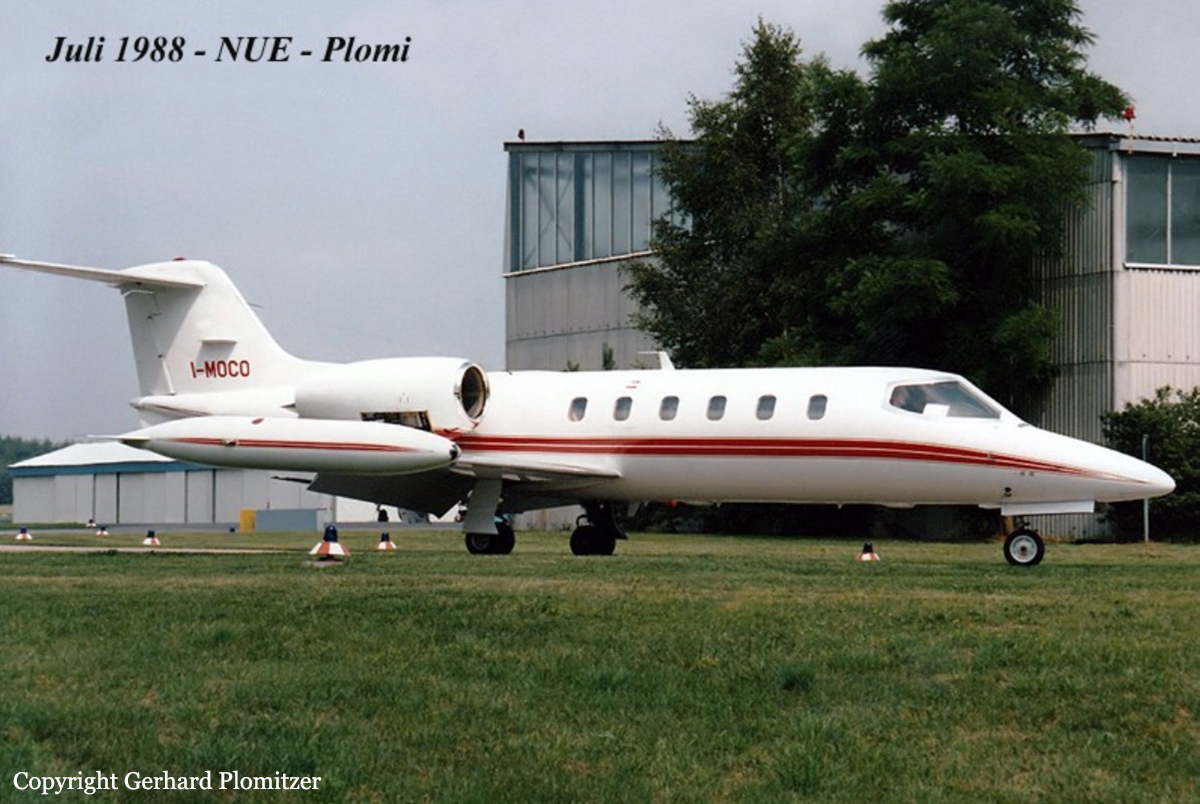
Crash of a Learjet 35 in Schenectady
Date & Time:
Jan 4, 2001 at 1547 LT
Registration:
N435JL
Survivors:
Yes
Schedule:
Schenectady – New York-LaGuardia
MSN:
35-018
YOM:
1975
Crew on board:
2
Crew fatalities:
Pax on board:
1
Pax fatalities:
Other fatalities:
Total fatalities:
0
Captain / Total hours on type:
1065.00
Copilot / Total hours on type:
497
Aircraft flight hours:
16302
Circumstances:
The captain stated that prior to departure the flight controls were tested, with no abnormalities noted, and the takeoff trim was set to the "middle of the takeoff range," without referring to any available pitch trim charts. During the takeoff roll, the pilot attempted to rotate the airplane twice, and then aborted the takeoff halfway down the 4,840 foot long runway, because the controls "didn't feel right." The airplane traveled off the departure end of the runway and through a fence, and came to rest near a road. The pilot reported no particular malfunction with the airplane. Examination of the airplane revealed that the horizontal stabilizer was positioned at -4.6 degrees, the maximum nose down limit within the takeoff range. The horizontal stabilizer trim and elevator controls were checked, and moved freely through their full ranges of travel. According to the AFM TAKEOFF TRIM C.G. FUNCTION chart, a horizontal stabilizer trim setting of -7.2 was appropriate with the calculated C.G. of 20% MAC. Additionally, Learjet certification testing data stated that the pull force required at a trim setting of -6.0 degrees, the "middle of the takeoff range", was 33 pounds. With the trim set at the full nose down position (-1.7 degrees), 132 pounds of force was required.
Probable cause:
The pilot's improper trim setting, which resulted in a runway overrun and impact with a fence.
Final Report:

Crash of a Learjet 35A in Lyon: 2 killed
Date & Time:
May 2, 2000 at 1439 LT
Registration:
G-MURI
Survivors:
Yes
Schedule:
Farnborough - Nice
MSN:
35-646
YOM:
1988
Flight number:
NEX4B
Crew on board:
2
Crew fatalities:
Pax on board:
3
Pax fatalities:
Other fatalities:
Total fatalities:
2
Captain / Total hours on type:
2113.00
Copilot / Total hours on type:
850
Aircraft flight hours:
4291
Aircraft flight cycles:
3637
Circumstances:
The aircraft departed Farnborough Airport at 11h22 on a charter flight to Nice with two pilots and three passengers on board, among them the F1 driver David Coulthard. At 12h22, cruising at FL390, the left engine of the aircraft suffered a failure. The crew shut down and began to descend. They declared an emergency and asked to fly to the nearest aerodrome with a runway longer than one thousand six hundred metres. Lyon-Satolas Airport, located about 62 NM away left abeam of the aircraft, was proposed. The descent with one engine shut down towards Lyon-Satolas was undertaken under radar guidance, at a high speed and with a high rate of descent. At 12h35, the pilot stabilised the aircraft at 3,000 feet, intercepted the runway 36L ILS and was cleared to land. The final was started at 233 knots according to radar data and the slow down progressive. At 12h36 min 45 s, the flaps were extended to 8°. According to the radar data, the aircraft was then at 2,400 feet, 4,4 NM from the runway threshold and at a speed of 184 knots. At 12h36 min 58 s, the landing gear was extended. At 12h37 in 03 s, the flaps were set to 20°. According to the radar data, the aircraft was then at 2,100 feet, 3,5 NM from the runway threshold at a speed of 180 knots. No malfunctions or additional problems were announced to the ATC by the crew during the final approach. At 12h38 min 08 s, the copilot told the captain that the aircraft was a little low. According to the radar data, the aircraft was then at 1,100 feet, 0,9 NM from the runway threshold at a speed of 155 knots. At 12h38 min 17 s, he repeated his warning and announced a speed 10 knots above the approach reference speed. At 12h38 min 22 s, the copilot again stated that the aircraft was a little low on the approach path and immediately afterwards asked the captain to increase the thrust. According to the radar data, the aircraft was then at 900 feet, 0,1 NM from the runway threshold at a speed of 150 knots. At 12h38 min 24 s, the captain indicated that he was losing control of the aircraft. The aircraft, over the runway threshold, banked sharply to the left, touched the ground with its wing, crashed and caught fire. Both pilots were killed while all three passengers evacuated with minor injuries.
Probable cause:
The accident resulted from a loss of yaw and then roll control which appears to be due to a failure of monitor flight symmetry at the time of the thrust increase on the right engine. The hastiness exhibited by the captain, and his difficulty in coping with the stress following the engine failure, contributed to this situation.
Final Report:


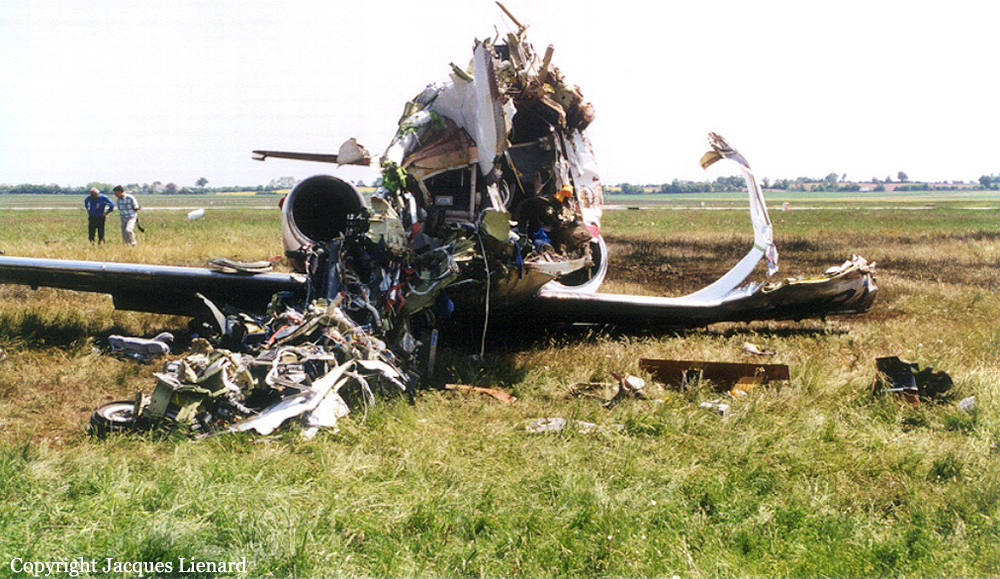
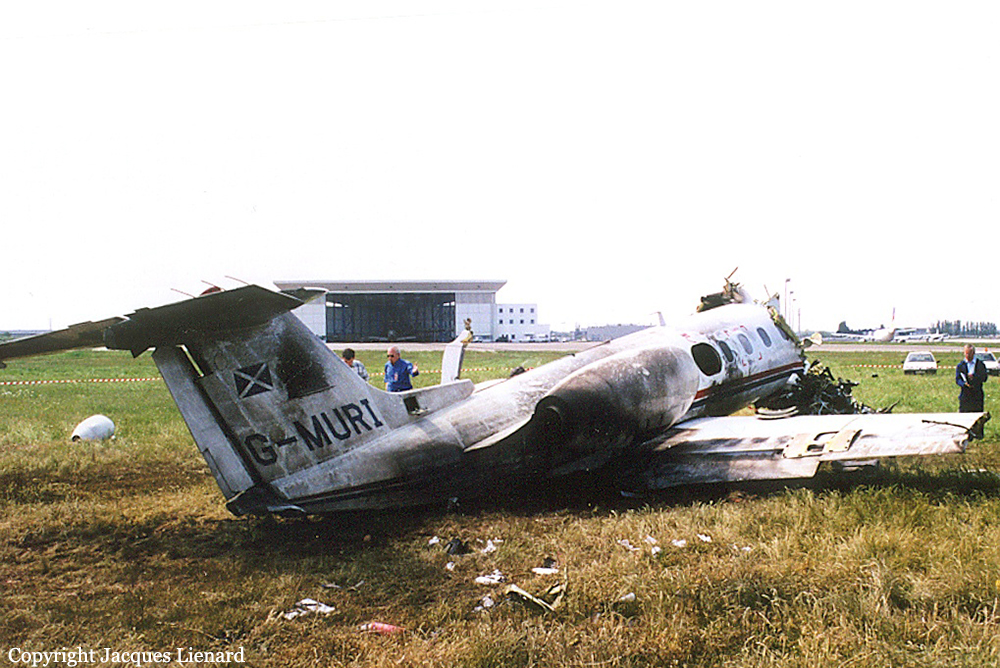
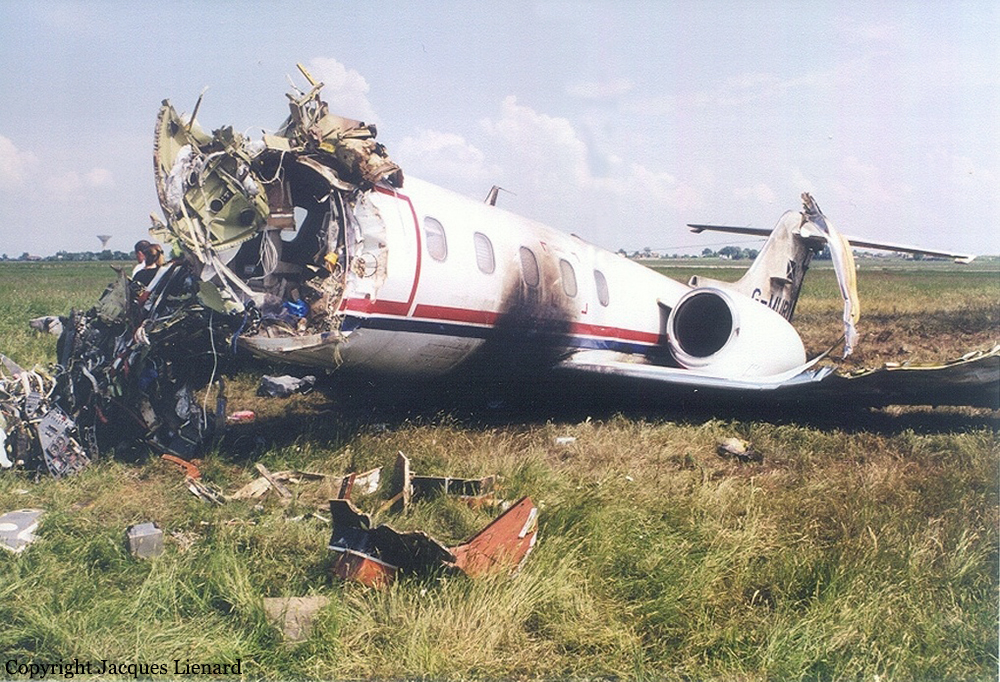
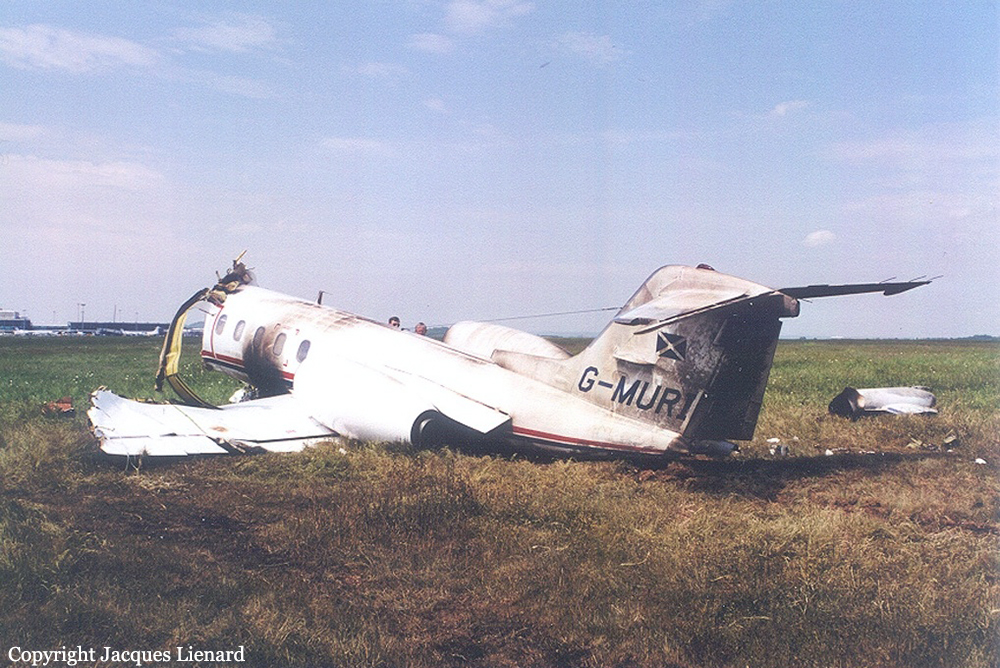
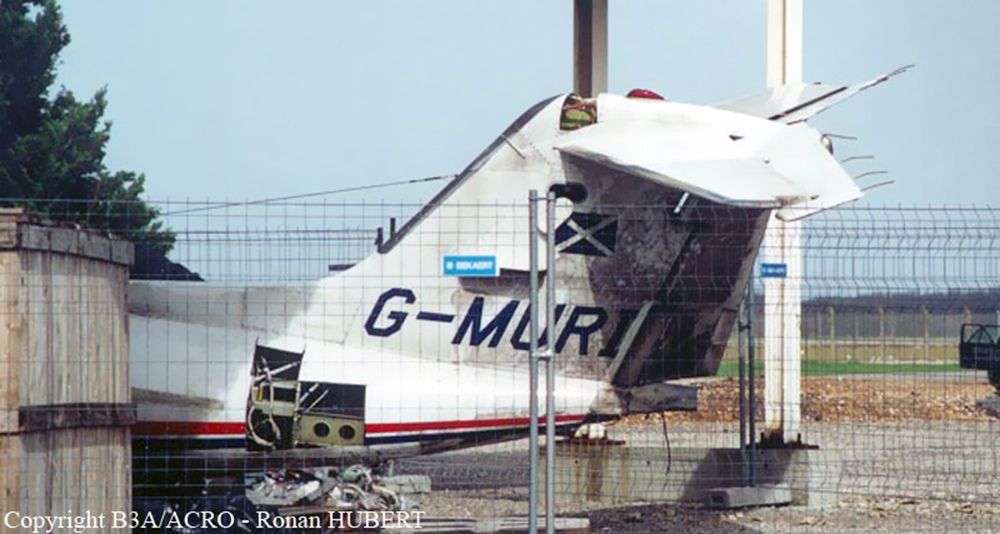

Crash of a Learjet 35A in Marianna: 3 killed
Date & Time:
Apr 5, 2000 at 0930 LT
Registration:
N86BE
Survivors:
No
Schedule:
Miami - Marianna
MSN:
35-194
YOM:
1978
Crew on board:
3
Crew fatalities:
Pax on board:
0
Pax fatalities:
Other fatalities:
Total fatalities:
3
Copilot / Total hours on type:
343
Aircraft flight hours:
13262
Circumstances:
The pilot canceled the IFR flight plan as the aircraft crossed the VOR and reported the airport in site. The last radio contact with Air Traffic Control was at 0935:16. The crew did not report any problems before or during the accident flight. The distance from the VOR to the airport was 4 nautical miles. Witnesses saw the airplane enter right traffic at a low altitude, for a landing on runway 36, then turn right from base leg to final, less than a 1/2-mile from the approach end of the runway. Witnesses saw the airplane pitch up nose high, and the right wing dropped. The airplane than struck trees west of the runway, struck wires, caught fire, and impacted on a hard surface road. This was a training flight for the left seat pilot to retake a Learjet type rating check ride he had failed on March 24, 2000. He failed the check ride, because while performing an ILS approach in which he was given a simulated engine failure, and he was transitioning from instruments to VFR, he allowed the airspeed to decrease to a point below Vref [landing approach speed]. According to the company's training manual, "...if a crewmember fails to meet any of the qualification requirements because of a lack in flight proficiency, the crewmember must be returned to training status. After additional or retraining, an instructor recommendation is required for reaccomplishing the unsatisfactory qualification requirements." The accident flight was dispatched by the company as a training flight. On the accident flight a company check airman was in the right seat, and the check ride was set up for 0800, April 5,2000. The flight arrived an hour and a half late. The left seat pilot's, and the company's flight records did not indicate any training flights, or any other type of flights, for the pilot from March 24, 2000, the date of the failed check flight, and the accident flight on April 5, 2000. The accident flight was the first flight that the left seat pilot was to receive retraining, and was the only opportunity for him to demonstrate the phase of flight that he was unsuccessful at during the check flight on March 24th. Examination of the
airframe and engine did not reveal any discrepancies.
airframe and engine did not reveal any discrepancies.
Probable cause:
The pilot's failure to maintain control of the airplane while on final approach resulting in the airplane striking trees. Factors in this accident were: improper planning of the approach, and not obtaining the proper alignment with the runway.
Final Report:
